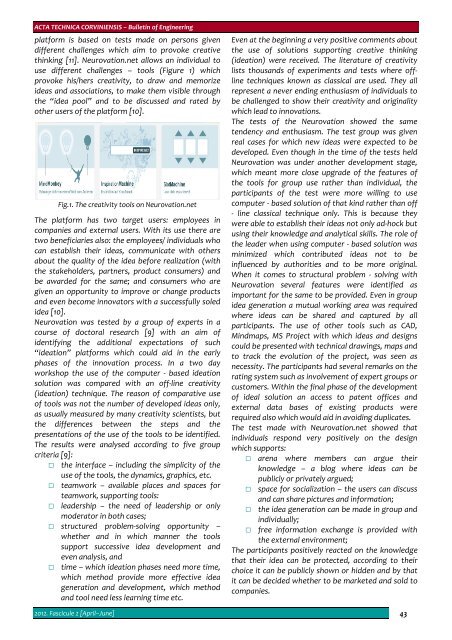Editorial & Advisory Board - Acta Technica Corviniensis
Editorial & Advisory Board - Acta Technica Corviniensis
Editorial & Advisory Board - Acta Technica Corviniensis
Create successful ePaper yourself
Turn your PDF publications into a flip-book with our unique Google optimized e-Paper software.
ACTA TECHNICA CORVINIENSIS – Bulletin of Engineering<br />
platform is based on tests made on persons given<br />
different challenges which aim to provoke creative<br />
thinking [11]. Neurovation.net allows an individual to<br />
use different challenges – tools (Figure 1) which<br />
provoke his/hers creativity, to draw and memorize<br />
ideas and associations, to make them visible through<br />
the “idea pool” and to be discussed and rated by<br />
other users of the platform [10].<br />
Fig.1. The creativity tools on Neurovation.net<br />
The platform has two target users: employees in<br />
companies and external users. With its use there are<br />
two beneficiaries also: the employees/ individuals who<br />
can establish their ideas, communicate with others<br />
about the quality of the idea before realization (with<br />
the stakeholders, partners, product consumers) and<br />
be awarded for the same; and consumers who are<br />
given an opportunity to improve or change products<br />
and even become innovators with a successfully soled<br />
idea [10].<br />
Neurovation was tested by a group of experts in a<br />
course of doctoral research [9] with an aim of<br />
identifying the additional expectations of such<br />
“ideation” platforms which could aid in the early<br />
phases of the innovation process. In a two day<br />
workshop the use of the computer ‐ based ideation<br />
solution was compared with an off‐line creativity<br />
(ideation) technique. The reason of comparative use<br />
of tools was not the number of developed ideas only,<br />
as usually measured by many creativity scientists, but<br />
the differences between the steps and the<br />
presentations of the use of the tools to be identified.<br />
The results were analysed according to five group<br />
criteria [9]:<br />
the interface – including the simplicity of the<br />
use of the tools, the dynamics, graphics, etc.<br />
teamwork – available places and spaces for<br />
<br />
teamwork, supporting tools:<br />
leadership – the need of leadership or only<br />
moderator in both cases;<br />
structured problem‐solving opportunity –<br />
whether and in which manner the tools<br />
support successive idea development and<br />
even analysis, and<br />
<br />
time – which ideation phases need more time,<br />
which method provide more effective idea<br />
generation and development, which method<br />
and tool need less learning time etc.<br />
Even at the beginning a very positive comments about<br />
the use of solutions supporting creative thinking<br />
(ideation) were received. The literature of creativity<br />
lists thousands of experiments and tests where offline<br />
techniques known as classical are used. They all<br />
represent a never ending enthusiasm of individuals to<br />
be challenged to show their creativity and originality<br />
which lead to innovations.<br />
The tests of the Neurovation showed the same<br />
tendency and enthusiasm. The test group was given<br />
real cases for which new ideas were expected to be<br />
developed. Even though in the time of the tests held<br />
Neurovation was under another development stage,<br />
which meant more close upgrade of the features of<br />
the tools for group use rather than individual, the<br />
participants of the test were more willing to use<br />
computer ‐ based solution of that kind rather than off<br />
‐ line classical technique only. This is because they<br />
were able to establish their ideas not only ad‐hock but<br />
using their knowledge and analytical skills. The role of<br />
the leader when using computer ‐ based solution was<br />
minimized which contributed ideas not to be<br />
influenced by authorities and to be more original.<br />
When it comes to structural problem ‐ solving with<br />
Neurovation several features were identified as<br />
important for the same to be provided. Even in group<br />
idea generation a mutual working area was required<br />
where ideas can be shared and captured by all<br />
participants. The use of other tools such as CAD,<br />
Mindmaps, MS Project with which ideas and designs<br />
could be presented with technical drawings, maps and<br />
to track the evolution of the project, was seen as<br />
necessity. The participants had several remarks on the<br />
rating system such as involvement of expert groups or<br />
customers. Within the final phase of the development<br />
of ideal solution an access to patent offices and<br />
external data bases of existing products were<br />
required also which would aid in avoiding duplicates.<br />
The test made with Neurovation.net showed that<br />
individuals respond very positively on the design<br />
which supports:<br />
arena where members can argue their<br />
knowledge – a blog where ideas can be<br />
publicly or privately argued;<br />
space for socialization – the users can discuss<br />
and can share pictures and information;<br />
the idea generation can be made in group and<br />
<br />
individually;<br />
free information exchange is provided with<br />
the external environment;<br />
The participants positively reacted on the knowledge<br />
that their idea can be protected, according to their<br />
choice it can be publicly shown or hidden and by that<br />
it can be decided whether to be marketed and sold to<br />
companies.<br />
2012. Fascicule 2 [April–June] 43

















